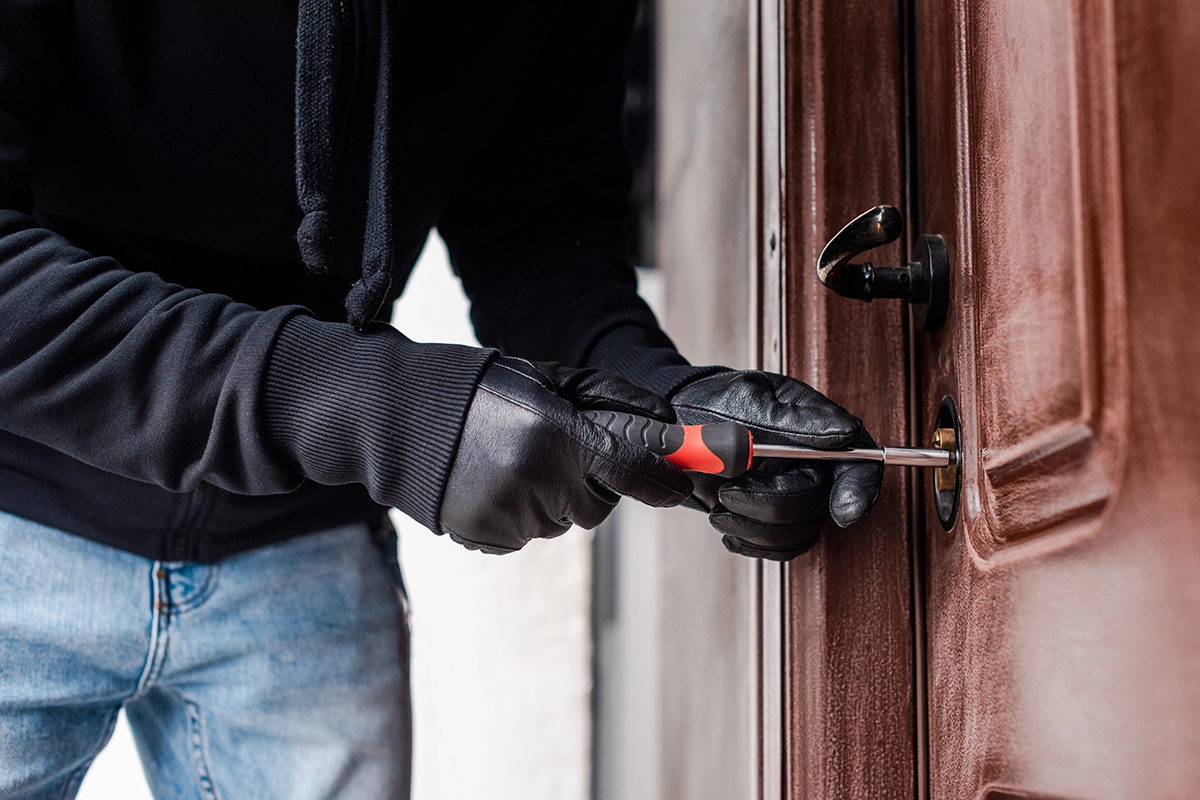If you are facing breaking and entering charges, you need a criminal defence lawyer in Calgary to look at your case as soon as possible. You might also benefit from consulting our specialized Breaking and Entering Lawyers in Calgary for targeted advice.
Breaking and entering is a serious criminal offence in Canada. This crime is when someone breaks into and enters a place with the intent to commit an indictable offence inside. The “breaking” part doesn’t necessarily mean smashing a window or door, even opening an unlocked door or window can count as breaking if you don’t have permission to enter.
Breaking and entering offences are divided into categories based on where the offence takes place.
- The most serious version is breaking into a dwelling-house (someone’s home), which is always an indictable offence. If convicted, you could face life imprisonment; see our insights on the Jail Sentence in Calgary, which is the maximum penalty.
- Breaking into other places, like businesses, schools, or storage facilities, is treated as a hybrid offence. This means the Crown prosecutor can choose to proceed by indictment for more serious cases or by summary conviction for less serious situations.
- If prosecuted by indictment, breaking and entering into a place other than a dwelling-house carries a maximum penalty of 10 years imprisonment. If prosecuted by summary conviction, you could face up to two years less in jail, a fine of up to $5,000, or both.
Strategic Criminal Defence is a top Google-rated criminal defence firm in Calgary, with over 500 5-star reviews. Our firm, and our experienced legal team, have defended clients in over 10,000 criminal cases. Leveraging our extensive network of lawyers and decades of experience, we craft defence strategies to help those accused of breaking and entering beat the charge.
The lawyers at Strategic Criminal Defence are both highly experienced and dedicated to defending your rights and future in the face of these charges. Contact a lawyer today by calling (403) 719-6410.
Key Takeaways
- Breaking and entering is when someone breaks into a place with the intent to commit a crime.
- Breaking into someone’s home (dwelling-house) is the most serious type of breaking and entering, it can lead to a sentence of life imprisonment.
- Breaking into businesses or other buildings is a hybrid offence. If you are found guilty by indictment, you could spend up to 10 years in jail. You could get up to two years if processed summarily.
- A common condition for bail is to stay away from the place where the break-in happened, not have any tools for breaking in, and be under house arrest.
- People who break into other people’s homes can face jail time even for a first offence.
- If there is doubt about identity, what the accused intended to do, or whether they had permission to enter, these charges can be dropped.
- Our team can look for important issues with the Crown’s case and these charges can be successfully challenged.
How Our Lawyers Help With a Breaking and Entering Charge
Our lawyers can protect your current and future interests when you are facing these serious charges.
We can give you legal advice about whether or not you should talk to the police before charges are filed. In some situation, this might stop the case from going any further.
We can get proof like security camera footage, witness statements, or electronic records that could show you weren’t there or that you had permission to be there.
If the case has to go to trial, our lawyers might hire experts, like forensic analysts, to look at fingerprint or DNA evidence that the police say links you to the crime scene.
Our lawyers know exactly what the Crown has to show, like that the person intended to commit a crime on the property. We can help you with the court process, and we might be able to get you lower charges or other options. We can also represent you well in court.
Examples of Breaking and Entering Charges
In Calgary, you could be charged with breaking and entering in the following situations:
- Someone sees vacation pictures of a family on social media and realizes that they are on vacation. They break into the family’s house through the back door and steal money, jewellery, and electronics. This person would be charged with breaking and entering a home, which is the most severe kind of break-in because it violates someone’s home.
- Two teens break into a high school at night by climbing through a window that is open. They spray paint the walls and steal computers from classrooms. They would be charged with breaking and entering a place other than a home with the intent to commit a crime (theft and mischief).
- A former worker who was just fired uses their old key card, which was never turned off, to get into their old workplace after hours. They break into the company’s computer system and delete important files. This is still breaking and entering even though they used a key card because they weren’t allowed to be there anymore.
- In a mall parking lot, someone breaks the window of a parked car and steals things from inside. “Place” includes vehicles, so this counts as breaking and entering.
Consequences of a Breaking and Entering Charge
In Canada, breaking and entering can lead to very severe punishments that can change your life forever.
These consequences depend on what kind of place was broken into and how the Crown decides to handle the case.
- Breaking into someone’s house and going inside without permission is always an indictable offence. If you are found guilty, you could face life imprisonment. There is no minimum time that must be served.
- If you break into places other than homes, like businesses, schools, or storage facilities, the crime is a hybrid offence.
- This means that the Crown prosecutor can choose to go ahead with an indictment for more serious cases or a summary conviction for less serious ones.
- If proceeded with by indictment, they can spend up to 10 years in jail. If you are found guilty by summary conviction, you could spend up to two years in jail, pay a fine of up to $5,000, or both.
In addition to these direct punishments, a conviction for breaking and entering will leave you with a criminal record that can make it harder for you to get a job, travel to other countries, or obtain certain licences. For a broader overview of potential outcomes, you may also be interested in our details on Criminal Sentencing in Calgary.
Breaking and Entering Charge Defences
These are some defences that might apply in different situations:
- Lack of Intent: The Crown must show that you entered the property with the intent to commit an indictable offence inside. Such as, theft, assault, or mischief. If you went into a place without permission but didn’t mean to break the law inside, this key part is missing. If you went into an empty building just to look around or take pictures, or if you went into a business to get out of the bad weather, or if you went into a building while drunk and didn’t know where you were, you might not have the criminal intent needed to be found guilty.
- Excuse or Permission: To be guilty of breaking and entering, you must have entered without permission. This defence might work if you were a tenant who still had keys and thought it was okay to enter or if you had been given permission to enter the property before. It can also apply when there is a misunderstanding, like when you thought you were welcome on the property because of something you did in the past or a talk with the owner. You may have technically broken the law by going in without permission, but that doesn’t mean you broke and entered with the intention of committing a crime inside.
- Charter Rights: If the police violated your rights under the Canadian Charter of Rights and Freedoms while they were looking into the case, your charges could be dropped. Even if the evidence points to you as the person who broke into a building, this could impact admissible evidence. In cases of breaking and entering, common Charter violations are searching your home or car without a proper warrant, taking evidence without a good reason, holding you without a good reason, denying you your right to counsel when you are arrested, or getting statements from you without telling you that you have the right to remain silent.
Breaking and Entering Charge Investigation
This process is usually started when a property owner learns about the break-in and calls the police.
- When the police investigate a case of breaking and entering, they attend the scene first to look to find evidence and suspects as soon as possible.
- First, police look for ways a person could have entered in, like broken doors or windows.
- They take pictures and write down everything they see at the scene, paying special attention to any damage to property, footprints, fingerprints, or other physical evidence.
- Police will look for fingerprints on things the intruder probably touched, like doorknobs, window frames, or countertops.
- When they can, investigators collect DNA evidence, like blood if the intruder got hurt while breaking in, or things where they might have left hair or saliva.
- They will also get video from the property and nearby buildings, which is often very helpful for figuring out a viable suspect.
Bail Conditions for Breaking and Entering Charges
If you commit a break and entering offence, it may be challenging to argue to be granted bail.
- If you are released, one of the most common rules for bail is that you have to stay at home or be there by a certain time each night.
- If the circumstances of your offence are very serious, the court might require you to stay home all the time. The only exceptions are when you have to go to court, meet with your lawyer, or go to work.
- You might also have to wear an electronic monitoring bracelet that keeps track of where you are to make sure you follow these bail conditions.
- The court will almost always not let you have any tools that could be used to break into a building, like crowbars, bolt cutters, lock-picking tools, or other things. You will also be told to stay away from the area where the break-in is said to have happened, and you will have to stay a certain distance away from it.
- You might have to check in with a police station or bail supervisor on a regular basis, like once a week or more. You will probably need one or more sureties, who are responsible people who agree to keep an eye on you and lose money if you break your bail terms.
- You will be told to behave and keep the peace, which means you can’t break any more laws while you are out on bail.
For more information, visit our page on The Bail Hearing Process in Calgary.








